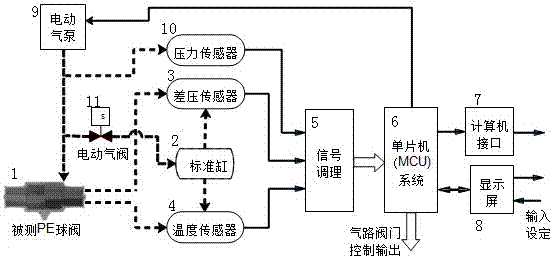Room temperature and low pressure test method for the tightness of polyethylene valves
A valve sealing and test method technology, which is applied in the direction of liquid tightness measurement by using liquid/vacuum degree, and by measuring the increase and decrease rate of fluid, can solve the problems of long test cycle, high cost, low efficiency, etc., and shorten the transition process, reduced equilibration time, effect of reduced test time
- Summary
- Abstract
- Description
- Claims
- Application Information
AI Technical Summary
Problems solved by technology
Method used
Image
Examples
Embodiment Construction
[0018] according to figure 1 As shown, the single-chip microcomputer system uses the electric air pump (9) to simultaneously pressurize the valve (1) test chamber and the standard cylinder (2) according to the given pressure requirements of the test. After the pressure sensor (10) obtains the actual pressure value of the compression, the single-chip microcomputer system The difference between it and the given pressure, under the control of a specific pressurization algorithm, realizes rapid pressurization of the cavity of the valve (1). This pressurization of the gas in the valve (1) test chamber and the standard cylinder (2) on the basis of atmospheric pressure may be accompanied by a slight temperature rise of the gas.
[0019] After the pressurization is completed, the electric gas valve (11) immediately cuts off the air channel between the tested valve (1) and the standard cylinder (2), and the differential pressure sensor (3) and temperature sensor (4) start to collect th...
PUM
 Login to View More
Login to View More Abstract
Description
Claims
Application Information
 Login to View More
Login to View More - R&D
- Intellectual Property
- Life Sciences
- Materials
- Tech Scout
- Unparalleled Data Quality
- Higher Quality Content
- 60% Fewer Hallucinations
Browse by: Latest US Patents, China's latest patents, Technical Efficacy Thesaurus, Application Domain, Technology Topic, Popular Technical Reports.
© 2025 PatSnap. All rights reserved.Legal|Privacy policy|Modern Slavery Act Transparency Statement|Sitemap|About US| Contact US: help@patsnap.com

